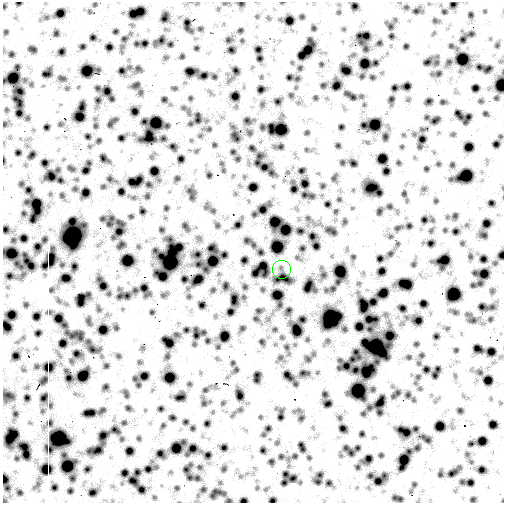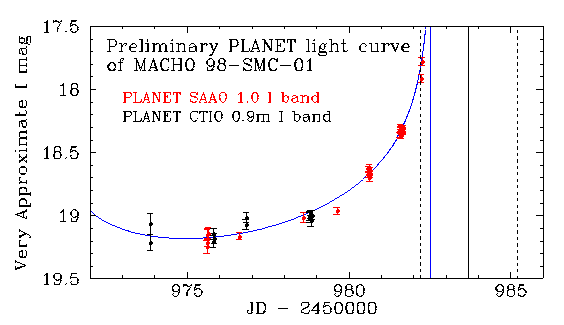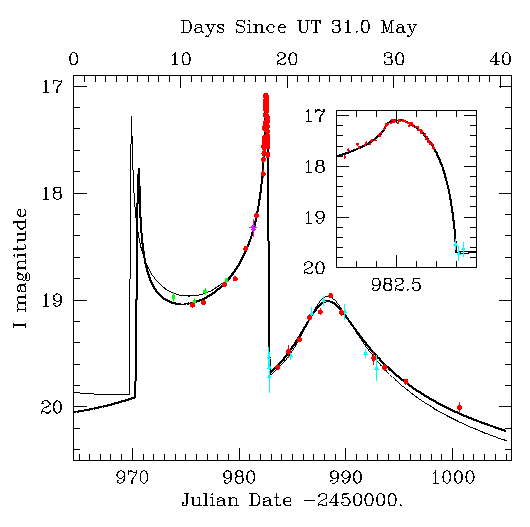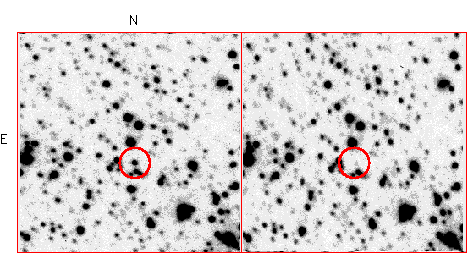

Event: MACHO 98-SMC-01
RA (J2000): 00:45:35.2
Dec (J2000) -72:52:34
Baseline MACHO V magnitude was initially reported by MACHO team to be 21.8, but has now been revised to V=21.4.
The PLANET finding chart shown (below, left) in reverse video is about 3 arcminutes on a side and was taken at the CTIO 0.9m telescope in the plateau region between caustic crossings when the event had magnification A near 9 in the I band. The MACHO finding chart shown (below, right) is about 5 arcminutes on a side and was taken in the MACHO R band when the event was at baseline. In both, North is up and East is to the left. Click on the images for a zoom.
 |
 |
This event in the Small Magellanic Cloud was discovered on 25 May 1998 by the MACHO team. On the 8th of June 1998, MACHO/GMAN issued an electronic Level-2 alert reporting this event to be a possible binary lens event currently in a flat plateau region between two caustic crossings. MACHO team preliminary fits (with assistance from S. Rhie) then indicated a second crossing could possibly occur between 21 and 27 June 1998.
PLANET observations of this event in the I band taken at the 36-inch (0.9m) telescope at CTIO detected a significant rise in brightness of about 0.15 magnitudes over the period around 11-12 June (UT). The reference stars used to perform the relative PLANET photometry remained constant during this period at the 0.01 magnitude level. PLANET issued an electric anomaly alert to the astronomical community on 12 June 1998 reporting this rise. If you would like to receive PLANET team electronic alerts of interesting microlensing events, click here.
The PLANET observations suggested that this event might be approaching a second caustic crossing sooner than previously predicted. It was important to monitor this event closely since source resolution effects near a caustic peak can be used to determine the proper motion of the lens, perhaps constraining whether the lens lies in the SMC or in the halo of the Milky Way. If the lens is in the SMC itself, it would have a velocity similar to that of the SMC background star, and would take longer to pass in front, creating a broader peak during the caustic crossing. A lens in the halo would probably be moving much more quickly, and would create a shorter-lived peak. Examples of what could occur in each scenario can be seen at the MACHO Alert Site on this event.
Continued PLANET observations over the period 11-15 June 1998 UT at three different telescopes in two different filters confirmed the rise in brightness for this event. PLANET observations on night of 16-17 June 1998 UT at SAAO indicated that event had brightened by 0.35 mag in 24 hours.
A preliminary pre-(second)caustic crossing PLANET light curve can be seen below. The vertical scale is approximate. PLANET Data taken in South Africa with the SAAO 1.0m are shown in red; PLANET data taken in Chile with the CTIO 0.9m are shown in black. Also shown as the vertical lines is the pre-peak MACHO-predicted window for the second caustic crossing at June 19.2 with MACHO-estimated uncertainty on this date of +/- 1.5 days. The PLANET model in blue is a preliminary point source model fitted to PLANET data on 17 June 1998, using publically available MACHO data to estimate the date of the first caustic crossing and the approximate event baseline. The PLANET model indicated that the second crossing would occur near 00:00 18 June 1998 UT. Separate fits done to PLANET data alone gave a similar result and so an electronic caustic alert was issued by PLANET.

The last two points in red were taken after the model was generated. The PLANET data shown above are preliminary; offsets between the CTIO and SAAO sites are likely due to blending. PLANET data from the SAAO 1m telescope on the night of 17-18 June confirmed that a caustic crossing did take place at almost the predicted time as can be seen from the light curve below included in our paper now published in Astrophysical Journal (Albrow et al, 1999, ApJ, 512, 672.)

In the full lightcurve above, the points in red were obtained with the SAAO 1m telescope in South Africa, green points are PLANET observations from the CTIO 0.9m in Chile, light blue points are from the Yale/CTIO 1m in Chile, and the magenta points were obtained with the Canopus 1m in Tasmania.
At the peak
of the lightcurve, the amplification was almost 100. Images of about 70 arc
seconds square extracted from frames obtained near the
peak (left) and two days later (right) are compared below.

Although the caustic crossing was now over, the source star in the SMC continued to be lensed for a time before returning to its normal brightness. Subsequent observations taken by PLANET have helped to constrain the geometry of the binary lens system the precise path it is traveling on the sky. This is necessary in order to determine which part of the complicated lens structure passed over the background star in the SMC. With this information, knowledge of the size of the background star, and the detailed shape of the light curve at the peak, the lens can be timed. The rather slow speed of the lens relative to the SMC star has led the PLANET collaboration to conclude that it is a likely to be a normal (binary) star in the SMC itself rather an object in the dark matter halo of the Milky Way. Technical details can be found in our paper published Astrophysical Journal (Albrow et al, 1999, 512, 672), which is available as the electronic archive astro-ph/9807086.
Updated MACHO information on the event can be found at the MACHO web page at: http://darkstar.astro.washington.edu
Updated EROS information on the event can be found at the EROS alert web page at: http://www.lal.in2p3.fr/EROS/